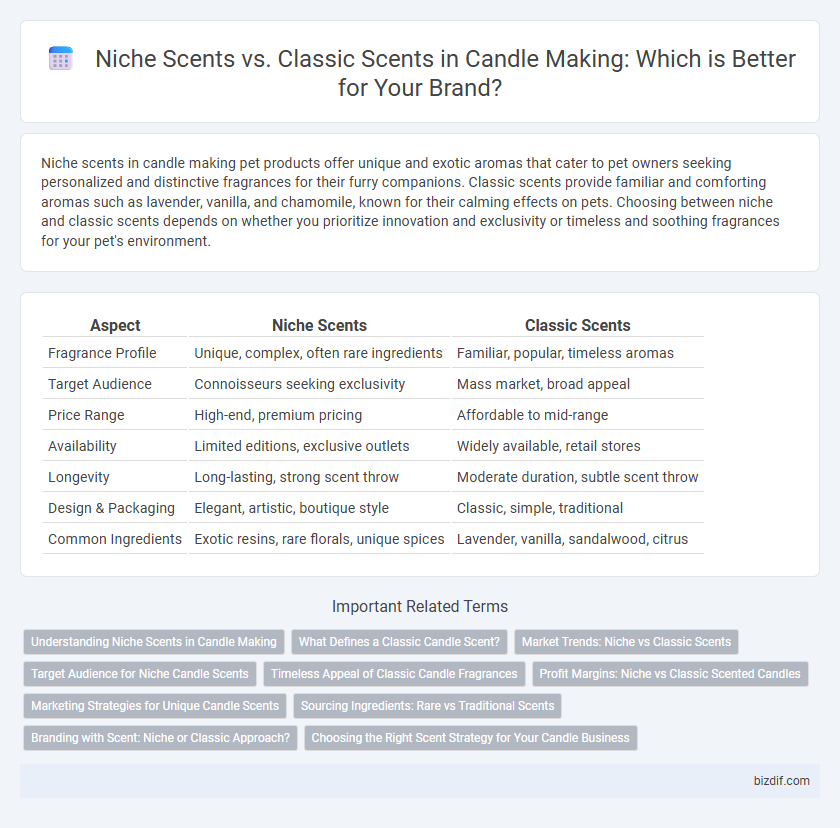Niche scents in candle making pet products offer unique and exotic aromas that cater to pet owners seeking personalized and distinctive fragrances for their furry companions. Classic scents provide familiar and comforting aromas such as lavender, vanilla, and chamomile, known for their calming effects on pets. Choosing between niche and classic scents depends on whether you prioritize innovation and exclusivity or timeless and soothing fragrances for your pet's environment.
Table of Comparison
| Aspect | Niche Scents | Classic Scents |
|---|---|---|
| Fragrance Profile | Unique, complex, often rare ingredients | Familiar, popular, timeless aromas |
| Target Audience | Connoisseurs seeking exclusivity | Mass market, broad appeal |
| Price Range | High-end, premium pricing | Affordable to mid-range |
| Availability | Limited editions, exclusive outlets | Widely available, retail stores |
| Longevity | Long-lasting, strong scent throw | Moderate duration, subtle scent throw |
| Design & Packaging | Elegant, artistic, boutique style | Classic, simple, traditional |
| Common Ingredients | Exotic resins, rare florals, unique spices | Lavender, vanilla, sandalwood, citrus |
Understanding Niche Scents in Candle Making
Niche scents in candle making are crafted from rare, high-quality ingredients that evoke unique and sophisticated aromas, setting them apart from classic scents like vanilla or lavender. These fragrances often blend unconventional notes such as oud, agarwood, or exotic spices, appealing to consumers seeking exclusivity and personalization. Understanding niche scents enables candle makers to create distinctive products that capture specific moods and environments, enhancing the sensory experience beyond traditional scent profiles.
What Defines a Classic Candle Scent?
A classic candle scent is defined by its timeless appeal and widespread recognition, often featuring familiar aromas like vanilla, lavender, sandalwood, or fresh linen that evoke comfort and nostalgia. These scents maintain consistent popularity due to their subtle, balanced profiles that suit a variety of settings and preferences. Unlike niche scents, which explore unique, unconventional combinations and innovative fragrance notes, classic candle scents prioritize broad appeal and enduring sensory familiarity.
Market Trends: Niche vs Classic Scents
Niche scents in candle making are rapidly gaining market share due to consumer demand for unique, artisanal fragrances that offer personalized sensory experiences. Classic scents like lavender, vanilla, and cinnamon remain consistent bestsellers, providing timeless appeal and mass-market reliability. Market trends indicate a growing preference for niche scents driven by millennial and Gen Z buyers seeking exclusivity, while classic scents sustain their presence through established brand loyalty and broad accessibility.
Target Audience for Niche Candle Scents
Niche candle scents attract a target audience seeking unique, artisanal fragrances that differ from mainstream options, appealing to connoisseurs and hobbyists who value exclusivity and complexity in aroma profiles. These consumers often prioritize ingredients sourced sustainably and appreciate small-batch craftsmanship, making them willing to invest in higher-priced, rare scents. Unlike classic scents, which appeal broadly due to familiarity and traditional appeal, niche scents cater to discerning customers looking for personal expression and distinctive sensory experiences.
Timeless Appeal of Classic Candle Fragrances
Classic candle fragrances such as lavender, vanilla, and sandalwood have a timeless appeal that consistently resonates with consumers seeking familiarity and comfort. These scents evoke nostalgia and create a warm ambiance, making them a staple in both homes and commercial spaces worldwide. Compared to niche scents, classic fragrances maintain enduring popularity due to their versatility and broad olfactory acceptance.
Profit Margins: Niche vs Classic Scented Candles
Niche scented candles often demand higher price points due to unique, rare fragrance ingredients, leading to increased profit margins compared to classic scents. Classic scented candles benefit from established popularity and lower production costs, allowing for steady sales but narrower margins. Strategic pricing and targeted marketing of niche scents can maximize profitability in the competitive candle-making market.
Marketing Strategies for Unique Candle Scents
Niche candle scents leverage rare, artisanal fragrances like oud, fig leaf, or blackcurrant, targeting discerning consumers seeking exclusive sensory experiences, while classic scents such as lavender, vanilla, and cinnamon appeal to broader audiences desiring familiarity and comfort. Marketing strategies for niche scents emphasize storytelling, emphasizing the origin and craftsmanship of ingredients through luxury branding and limited edition releases to create a sense of exclusivity. In contrast, classic scents benefit from mass-market campaigns, seasonal promotions, and bundling offers that capitalize on their widespread recognition and universal appeal.
Sourcing Ingredients: Rare vs Traditional Scents
Niche scents in candle making often rely on rare, ethically sourced ingredients like exotic resins, uncommon florals, and unique spices, which provide distinctive and complex fragrance profiles. Classic scents, on the other hand, utilize traditional and widely available ingredients such as lavender, vanilla, and sandalwood, ensuring consistent quality and familiarity. The sourcing process for niche scents typically involves small-batch suppliers and sustainable harvesting practices, while classic scents benefit from established supply chains and economies of scale.
Branding with Scent: Niche or Classic Approach?
Niche scents offer candle brands a unique identity by incorporating rare, complex fragrance combinations that cater to specific customer tastes, enhancing exclusivity and brand differentiation. Classic scents such as lavender, vanilla, or sandalwood provide familiarity and broad appeal, fostering a sense of comfort and timelessness that can attract a wider audience. Choosing between niche or classic scents influences brand positioning, customer loyalty, and market reach in the competitive candle-making industry.
Choosing the Right Scent Strategy for Your Candle Business
Niche scents such as fig leaf, oud, or tobacco create exclusive appeal by targeting specific customer preferences, often commanding higher price points and brand loyalty. Classic scents like lavender, vanilla, or cinnamon offer broad market acceptance and steady sales due to their timeless familiarity and widespread consumer recognition. Selecting the right scent strategy depends on your target audience demographics, market positioning, and long-term brand vision to balance innovation with reliable demand.
Niche scents vs Classic scents Infographic

 bizdif.com
bizdif.com